Editor’s note: in the midst of the Ukraine crisis, OnePeterFive has been promoting devotion to the Russian icon of Our Lady of Fatima on every podcast. We promote this devotion not only for our brethren in Ukraine and Russia, but yet more for the intentions of our patroness, Our Lady of Fatima and the conversion of Russia. OnePeterFive does not take an editorial position regarding the various controversies on Fatima (now entering a new epoch since the Annunciation consecration of this past year). We are currently working to make this icon available for purchase in western Europe and the Americas as a means to support the shrine of Fatima for all Russia in St. Petersburg. For now, please donate to the shrine project here, and read our editorial approach to the Eastern Orthodox here. Join our mailing list for this apostolate by emailing me editor [at] onepeterfive.com. -TSF
Translated from the Russian by L. S. Predy
The Fatima Icon of the Mother of God “By Thee, Unity” (commemorated June 30/July 13) is one of the most famous icons of the 21st century in Russia. It was written in St. Petersburg after many years of prayerful reflection. The writing process itself lasted a year and a half. It involved a Catholic priest who contacted Sister Lucia of Fatima and an Orthodox icon writer who received permission to work from his monk confessor.
The deeper meaning of this icon lies in the whole history of Russia in the 20th century, its suffering and rebirth, as well as its connection with the Universal Church. For this reason, at present, in honor of this image, Catholics want to erect a sanctuary-monastery in St. Petersburg.
Fatima and Russia
The close connection of the message of Fatima with Russia has already inspired many people to participate in the revival of the veneration of the Theotokos on Russian soil. The icon of the Mother of God of Fatima, which I present to you, is a symbol that emphasizes the special relationship of the Blessed Virgin to Russia, manifested in her appearances on July 13, 1917 in Fatima (Portugal) and in June 1919 in Tuy (Spain). There, she spoke about the fact that “Russia will spread its false teachings throughout the world, that will entail wars and persecutions against the Church” and about Russia’s conversion to God after the Pope consecrates Russia to the Immaculate Heart of the Theotokos. It also serves as a reminder that after these apparitions, for decades, millions of people prayed for Russia, so that love for this country arose and prayers were offered up around the globe. In this sense, the icon can help Russia return this spiritual debt and express great gratitude to the Virgin of Fatima.
Creation of an Icon
The idea to write this icon arose during my trip to Moscow in 2000, but the final project began to mature only at the end of 2002, when I began my priestly ministry in Russia. First of all, I asked the opinion of several St. Petersburg priests, nuns and faithful, who encouraged me to carry out this plan. Then for several months I studied the iconography of the Mother of God and the existing images of the Virgin of Fatima.
Fatima and Coimbra
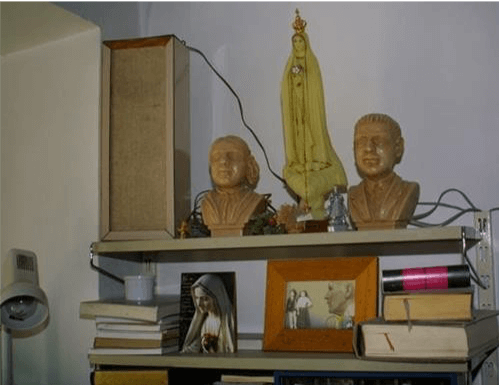
There are two main types of such images that are kept on the bookshelf in the room of Sister Lucia: the image of the Virgin of Fatima, which is located in the small chapel, at the place where the apparitions took place (Capelinha) and the image of the Immaculate Heart of Mary in Coimbra. This last image had the greatest influence on the creation of our icon, because, as it seemed to me, it corresponded most of all to the Eastern iconography of the Virgin and because Russia was dedicated to the Immaculate Heart of Mary.
The Iconographer Begins the Project
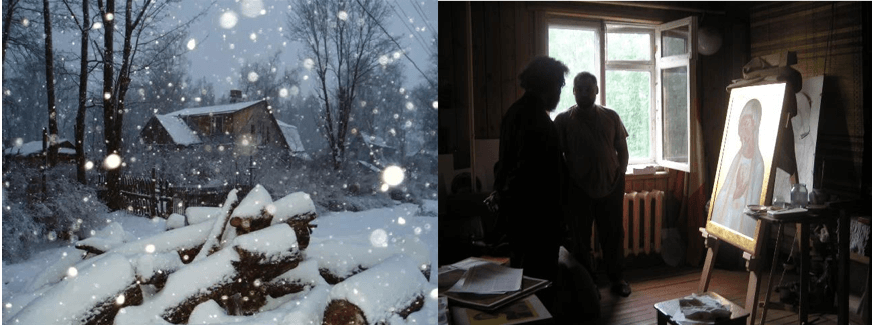
At the same time, Father Igor Chabanov introduced me to an Orthodox iconographer, who expressed his willingness to carry out the project, and we both set to work with the idea that if the icon is liked by a Catholic priest and a Russian artist, it will be possible to consider that our goal has been achieved. The iconographer took up deep study existing literature about Fatima, prayed, suffered through illnesses and faced many difficulties, but after one and half years he completed this miraculous icon of the Theotokos of Fatima.
Sister Lucia Saw the Icon
Throughout this lengthy process of creating the icon, Sister Lucia received photographs showing the evolution of the writing process. Although I usually responded to the abbess, I understood that she always showed the photos to Sister Lucia, since she answered in the plural – “we like it,” and so we continued with the project. To verify the veracity of my assumptions, after the death of Sister Lucia, I wrote to Sister Maria Selina, abbess of the monastery of Coimbra, asking her: “May I say that Sister Lucia liked the icon?” She responded in the affirmative, confirming that Sister Lucia saw the photographs and liked what was done by us in St. Petersburg. The only pity is that she died without seeing the work in completed form.
A Woman Clothed in the Sun
![]()
Here let us discuss this large icon worthy of becoming the main altar icon in a church, an icon of the Mother of God, shown here only to her waist, recalling ordinary Orthodox icons widely revered in Russia, for example, the Vladimir Theotokos or Our Lady of Kazan. At the same time, the main characteristic feature of the icon is that it is full of light. But it is the Virgin of Fatima who was full of light – that light, which, as the shepherd St. Francesco said, “is God.”
“Full of Grace” – that is, filled with the Lord, and at Fatima she is full of light: “The Woman Clothed with the Sun” (Rev. 12:1). This apparition at Fatima is therefore very similar to the theology of iconography as expressed in the Ecumenical Council Nicaea II and developed in the Greek Catholic tradition. There is an opinion that the first icon of any iconographer should be an icon of the Transfiguration (shown on the left) – for an iconographer must understand that an icon must bring closer the world of the divine to the world of men, the light of God to the earth, the radiance of God, seen in the renowned white clothes of the Transfigured Christ. This is also true of the icon of the Virgin of Fatima.
The Heart, Surrounded by Thorns
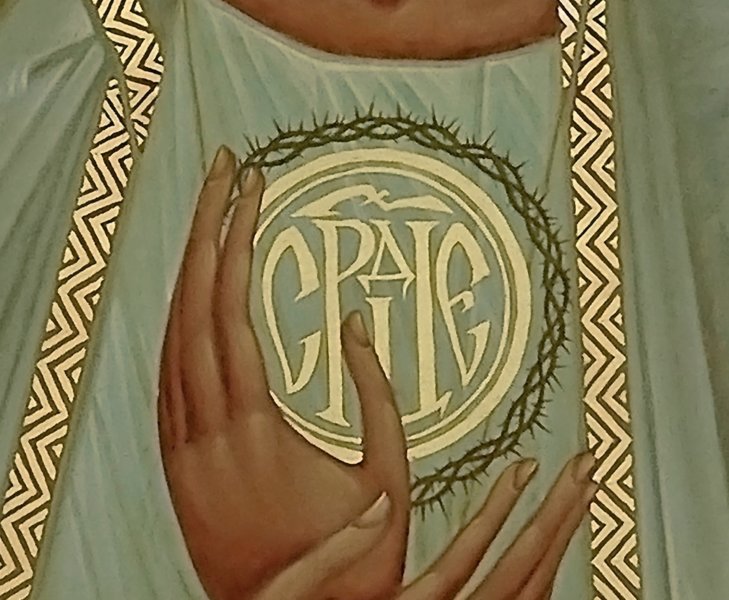 At the center of the icon is located a medallion with the word “heart” in Church Slavonic (the sacred language of Slavic Christendom approved by the Holy See under Ss. Cyril and Methodios). This detail was proposed by the iconographer Ivan Lvovich, to overcome the difficulty of portraying an image of a heart on the icon, something that the Orthodox viewer perceives as too carnal. At the same time the letters that speak of the reality of the Heart of Mary express it symbolically, according to iconographic tradition. The heart, surrounded by thorns, indicates Mary’s love for people and the pain caused by people’s lack of love for God. As a remedy for this pain, the Theotokos offers us a rosary, which she is holding in her hands. The iconographer depicted the beads in violet, as an image of the Cross, which every Christian must take up if they wish to follow the Lord. These beads also symbolize the Passion of the Lord, and represent, as it were, the very essence of the Message of Fatima, consisting in the words: “Prayer and penance.”
At the center of the icon is located a medallion with the word “heart” in Church Slavonic (the sacred language of Slavic Christendom approved by the Holy See under Ss. Cyril and Methodios). This detail was proposed by the iconographer Ivan Lvovich, to overcome the difficulty of portraying an image of a heart on the icon, something that the Orthodox viewer perceives as too carnal. At the same time the letters that speak of the reality of the Heart of Mary express it symbolically, according to iconographic tradition. The heart, surrounded by thorns, indicates Mary’s love for people and the pain caused by people’s lack of love for God. As a remedy for this pain, the Theotokos offers us a rosary, which she is holding in her hands. The iconographer depicted the beads in violet, as an image of the Cross, which every Christian must take up if they wish to follow the Lord. These beads also symbolize the Passion of the Lord, and represent, as it were, the very essence of the Message of Fatima, consisting in the words: “Prayer and penance.”
The Mission of the Icon for Our Separated Brethren
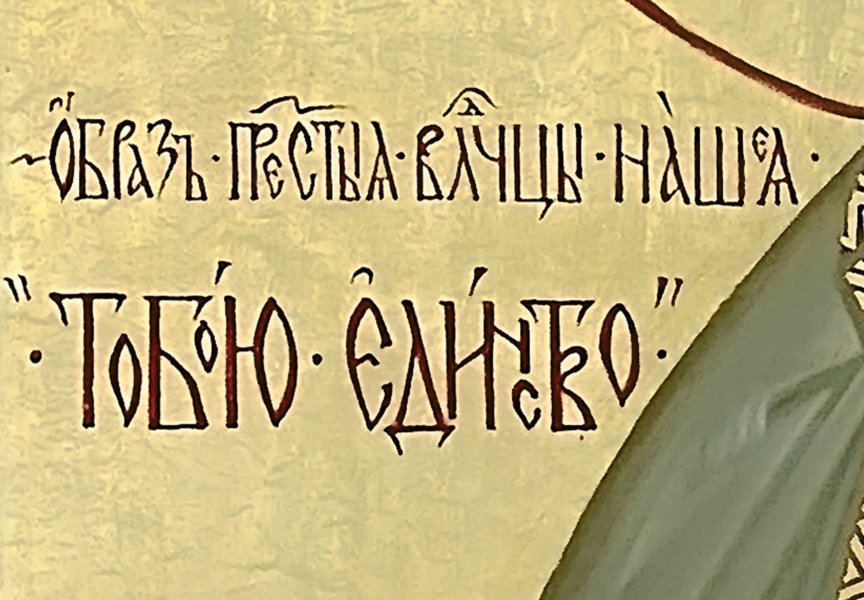
On the icon, in addition to the traditional Greek letters MP ΘY, indicating Mary/Theotokos, there are yet two inscriptions. The upper one represents the title of the icon: “The Image of Our Most Holy Lady, the Theotokos of Fatima.” At the bottom left the large letters say: “By Thee Unity.” These words remind us about the ecumenical mission of the icon, written through the joint efforts of a Catholic priest and an Orthodox iconographer with the goal of creating an image before which Catholics and Orthodox could pray. It expresses two important points regarding our separated brethren in the east: the unifying force of the Heart of Mary and that of martyrdom – closely related with the message of Fatima.
In fact, it is impossible to deny that all of us living in Russia are bound in a special way by love for Mary, just as it is obvious that we all have our place in her Mother’s Heart and we are all united in it. In addition, the call to unity that this icon contains is connected with the true ecumenism of that martyrdom, which is spoken of in the third mystery of Fatima, when it comes to the martyrdom of the Church in the twentieth century.
Knowing the history of Russia and, in particular, how in the prisons of the Soviet Gulag we – Orthodox and Catholics – suffered together, for the first time united by friendly relations, one can hope that the martyrs who appeared in the vision to the shepherds of Fatima include souls from both communions. The icon of Our Lady of Fatima is called, in this sense, to serve the unity of the Church in the person of Mary, who appeared at Fatima.
Common to both images are the slightly elongated shape of the face and the entire image of the Virgin Mary, the white color of her robe and veil, the rosary and the orb hanging on her chest – symbols that were preserved on the icon “Thy Unity.” From the Coimbra image, a border was taken, running along the edge of Our Lady’s garment, and the location is in the center of a heart surrounded by thorns. Finally, when the project had already been reviewed by me, I wrote to Sister Lucia in the Carmel of Coimbra to ask her opinion. On her behalf (besides the aforementioned correspondence), the abbess of the monastery answered me, who sent me the necessary information and approved this project.
Blessing the Icon in Tsarskoe Selo
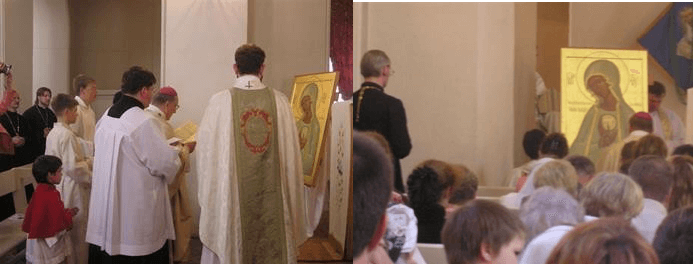
On June 24, 2006 the icon was solemnly blessed by the Roman Catholic Archbishop of Moscow, Most Rev. Tadeusz Kondrusiewicz, and installed in the Tsarskoye Selo Catholic Church of St. John the Baptist, under the patronage of the Theotokos. After all, three years prior, before it was dedicated to John the Baptist, the parish had been dedicated to the Immaculate Heart of Mary, to whom ascended prayers for the return to the faithful of this parish church, which had been confiscated in 1938 by the Communists.
After many ups and downs, the National Museum-Reserve of Tsarskoe Selo, decided to return the church property to our community (translator’s note: The village of Tsarskoe Selo, “Tsars’ Village,” was the familial residence of the Tsars until the assassination of Tsar Nicholas II by the Bolsheviks, after which the grounds became a national historic site and museum under the control of the government). June 24 was chosen as the day of return, which was simultaneously the parochial holiday of the Nativity of St. John the Forerunner and the patronal holiday of Tsarskoe Selo. Archbishop Tadeusz agreed to celebrate the ceremonial return and at the same time bless the icon. I initially thought the date was not very appropriate for blessing the icon, because it seemed to have no relation to the Theotokos… until I realized the detail that filled me with joy: the Feast of the Immaculate Heart of Mary was a movable feastday, which can fall between May 29 and July 2, in 2006 “absolutely accidentally” fell on June 24. Thus, the icon was blessed on the Feast of the Immaculate Heart, the same day the parish was returned to us.

On July 13 of the same year, on the feast day of the icon, since it was the day when the Theotokos spoke about Russia in her appearances in Fatima, the icon was solemnly transferred to a small chapel prepared for it in the same church. The ceremony was attended by members of the Catholic parish of the Byzantine rite of St. Petersburg, responsible for the transfer of the icon. Catholics of the Latin and Byzantine rites prayed the rosary together, participated in the Holy Mass and at the end sang the Akathist in honor of the Virgin.
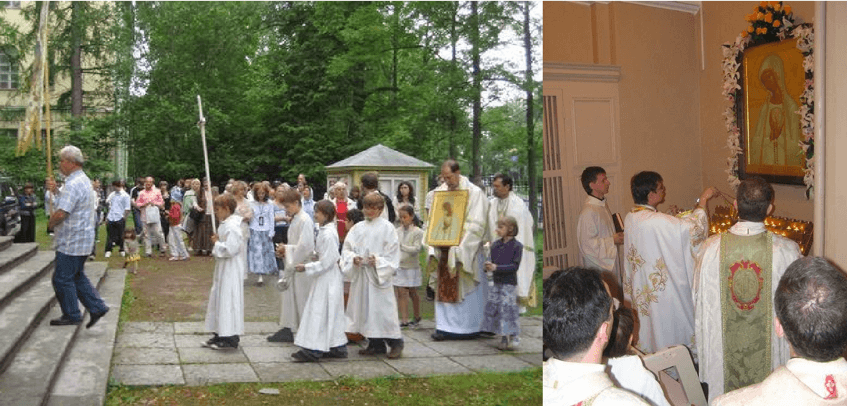
International Veneration of the Icon
From this time forward, veneration of the Icon spread in the Catholic Church throughout the world and even outside the Catholic Church. The most important instances of the veneration of the image of the Theotokos of Fatima by the hierarchy of the Catholic Church are as follows.
Visit of the Presidents of the Episcopal Conferences of Europe to Tsarskoe Selo in 2006:
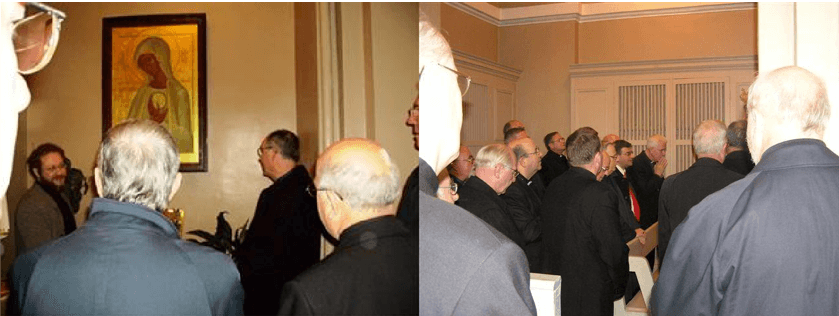
A copy of the icon was blessed in 2007 at the Sanctuary of Fatima on the occasion of the 90th anniversary of the Fatima Apparitions by Cardinal-Secretary of State Angelo Sodano in front of a crowd of 80 thousand people and its subsequent placement on July 13 for the benefit of the faithful in the “Capelinha” – the chapel where the apparitions took place:
![]()
The icon was in the room where Popes Francis spent his visit to Fatima in 2017:
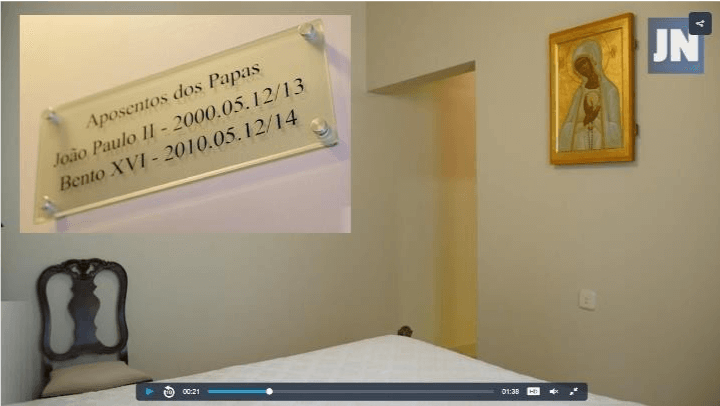 In Ukraine, a copy of the icon was consecrated in Donetsk by the Latin and Greek Catholic bishops of the region, as a result of which a small sanctuary was founded in 2008. Copies were also blessed by Patriarch Bartholomew of Constantinople, and then by Cardinal Dziwisz in Krakow. The Major Archbishop of the Ukrainian Greco-Catholic Church, Sviatoslav Shevchuk, often gives copies of this icon to his eminent guests, such as Cardinal Sandri, prefect of the Eastern Churches, and at some international Byzantine meetings he put it as the main icon, for example, at the celebration of the Florence Cathedral in the same city in 2019.
In Ukraine, a copy of the icon was consecrated in Donetsk by the Latin and Greek Catholic bishops of the region, as a result of which a small sanctuary was founded in 2008. Copies were also blessed by Patriarch Bartholomew of Constantinople, and then by Cardinal Dziwisz in Krakow. The Major Archbishop of the Ukrainian Greco-Catholic Church, Sviatoslav Shevchuk, often gives copies of this icon to his eminent guests, such as Cardinal Sandri, prefect of the Eastern Churches, and at some international Byzantine meetings he put it as the main icon, for example, at the celebration of the Florence Cathedral in the same city in 2019.
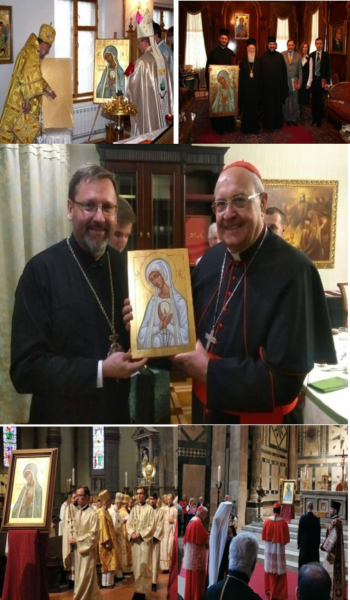 Also of great importance was the visit of the icon to all the parishes of Kazakhstan, organized in 2016-17 by the Kazakhstan Episcopal Conference:
Also of great importance was the visit of the icon to all the parishes of Kazakhstan, organized in 2016-17 by the Kazakhstan Episcopal Conference:

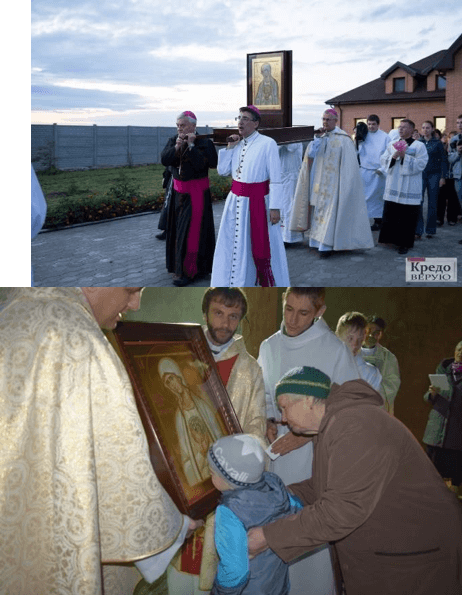 The choice of the icon as an image for veneration in all parishes of Russia on the occasion of the Year of the Blessed Virgin Mary – Mother of the Word of God 2020-2022 and its subsequent installation as a mosaic in the Basilica of Nazareth.
The choice of the icon as an image for veneration in all parishes of Russia on the occasion of the Year of the Blessed Virgin Mary – Mother of the Word of God 2020-2022 and its subsequent installation as a mosaic in the Basilica of Nazareth.
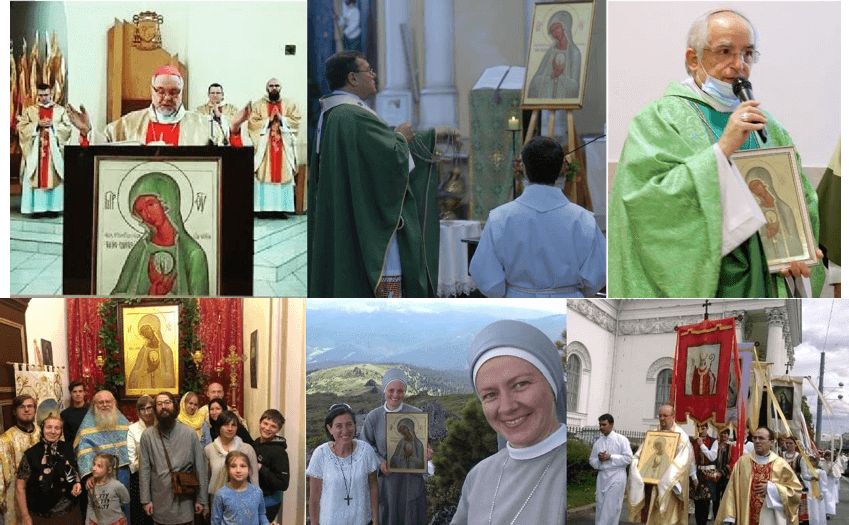 But perhaps the most important moment occurred during the Fatima Centenary Congress on May 13, 2017 in Karaganda (Kazakhstan), which gathered before the copy of the Fatima Icon, before which all the bishops of Russia and Kazakhstan consecrated Russia and Kazakhstan to the Immaculate Heart of the Virgin Mary under the chairmanship of the papal legate – Cardinal Joseph Cordes.
But perhaps the most important moment occurred during the Fatima Centenary Congress on May 13, 2017 in Karaganda (Kazakhstan), which gathered before the copy of the Fatima Icon, before which all the bishops of Russia and Kazakhstan consecrated Russia and Kazakhstan to the Immaculate Heart of the Virgin Mary under the chairmanship of the papal legate – Cardinal Joseph Cordes.
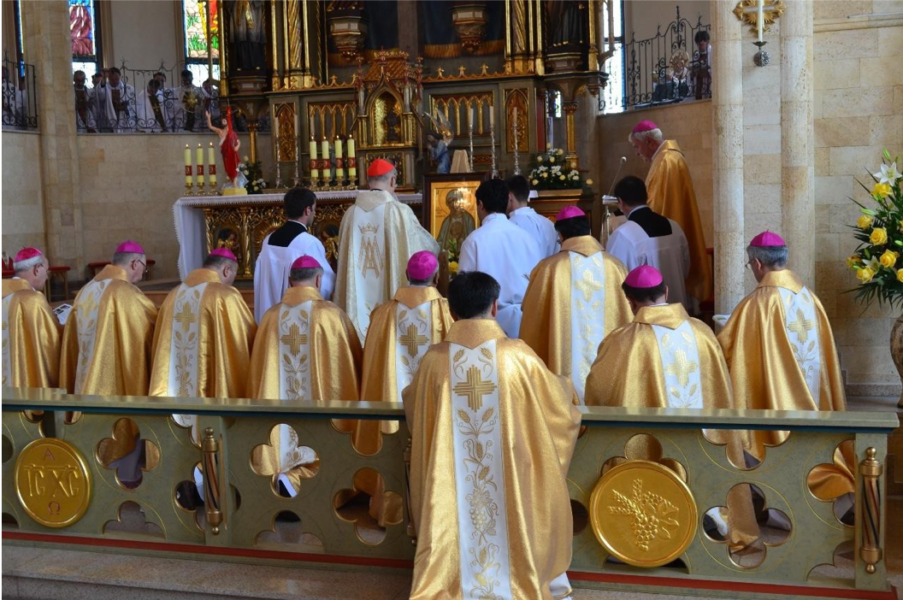 On the other hand, the veneration of the icon has spread almost all over the world, but especially in Russia, Kazakhstan and Ukraine. In addition to Russian, about a million printed publications about this image were distributed in fifteen other languages. A novena was published in honor of the Icon, and an Akathist was also written. The icon was reported in many magazines, including the Fatima Sanctuary and the Bulletin of the Moscow Diocese. Radio broadcasts were made about this image in St. Petersburg and Madrid. Also, several pilgrimage chapels have spread from Madrid, which pass through private houses so that the families living in them pray for Russia. The Association “Aid to the Church in Need” also did many of copies of the icon, which helped collect funds for their charitable projects.
On the other hand, the veneration of the icon has spread almost all over the world, but especially in Russia, Kazakhstan and Ukraine. In addition to Russian, about a million printed publications about this image were distributed in fifteen other languages. A novena was published in honor of the Icon, and an Akathist was also written. The icon was reported in many magazines, including the Fatima Sanctuary and the Bulletin of the Moscow Diocese. Radio broadcasts were made about this image in St. Petersburg and Madrid. Also, several pilgrimage chapels have spread from Madrid, which pass through private houses so that the families living in them pray for Russia. The Association “Aid to the Church in Need” also did many of copies of the icon, which helped collect funds for their charitable projects.
Copies of the Icon have been distributed all over the world: some notable ones are installed in the Sanctuary of Fatima, in Torreciudad, in Donetsk and in Kazakhstan. As far as we know, new copies have been written in Russia, Ukraine, France, Argentina, Poland, Bulgaria, Greece, Spain, Ireland, Korea, Israel and Bosnia.
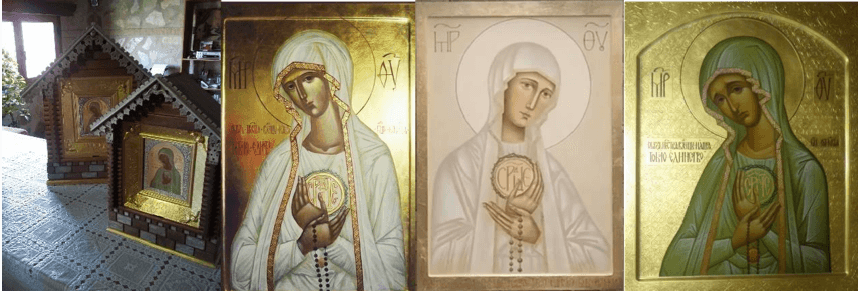
Fatima Shrine in St. Petersburg
Bishop Joseph Werth, S.J., Ordinary for Catholics of the Byzantine Rite in Russia, blessed me for the construction of a Shrine in honor of the Icon in the city of St. Petersburg.
After I received this blessing, we constructed a website for the proposed Shrine, available in English, Spanish and Portuguese: https://fatimarus.com/. Explanations of the icon in different languages can found at this blog: http://lapisalbus.blogspot.com/. More news about the Icon can be found at these public groups: https://www.facebook.com/groups/iconodefatima and https://vk.com/club12935056.
At the present time we are still searching for a site to begin construction. Our intention is to build a small wooden church at first, which may in turn, become the start of the National Shrine of the Icon of Fatima for all of Russia.

The feast of the icon is celebrated on July 13, the day when the Mother of God, during the apparitions in Fatima, first spoke about Russia and its future.
Editor’s note: the translator and editor have attempted to keep to the original meaning of Fr. Burgos’ Russian text, while having to make certain phrasing and stylistic changes for the sake of clarity for our English readers.

